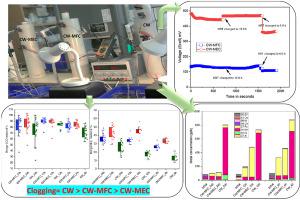Chemosphere ( IF 8.1 ) Pub Date : 2021-06-22 , DOI: 10.1016/j.chemosphere.2021.131296 Pratiksha Srivastava 1 , Rouzbeh Abbassi 2 , Asheesh Yadav 3 , Vikram Garaniya 1 , Mohsen Asadnia 2 , Trevor Lewis 4 , Stuart J Khan 5

|
A two-stage hybrid Constructed Wetland (CW) integrated with a microbial fuel cell (MFC), and microbial electrolysis cell (MEC) has been assessed for treatment performance and clogging assessment and further compared with CW. The CW-MEC was operated with applied potential to the working electrode and compared with the performance of naturally adapted redox potential of the CW-MFC system. A complex synthetic municipal wastewater was used during the study, which was composed of trace metals, organics, inorganics, and dye. The study demonstrated that providing a constant potential to the working electrode in CW-MEC has resulted in high treatment performance and reduced sludge generation. The maximum chemical oxygen demand (COD), ammonium (NH4+), and phosphate (PO43−) removal achieved during treatment by CW-MEC at 24 h hydraulic retention time was 89 ± 6%, 72 ± 6% and 93 ± 2%, respectively. ICP-MS results indicated that trace metal removals were also higher in CW-MEC than in CW alone (p < 0.05). At the end of the experiment, significant volumetric change (total volume of the microcosm) occurred in CW (1.3 L), which indicates high sludge generation, whereas it was lesser in CW-MEC (0.3 L) and in CW-MFC (0.5 L). Further, Energy Dispersive X-ray (EDX) spectroscopy results indicated low levels of metal precipitation in the CW-MEC system. Based on the Shannon diversity index, the CW-MEC was assessed to be characterised by high species richness and diversity. The observations from this study indicate that the applied potential at the working electrode has a significant impact on treatment performance and clogging behaviour of the system.
中文翻译:

外加电位对复合人工湿地-微生物电化学技术处理性能和堵塞行为的影响
已经评估了与微生物燃料电池 (MFC) 和微生物电解池 (MEC) 相结合的两级混合人工湿地 (CW) 的处理性能和堵塞评估,并进一步与 CW 进行了比较。CW-MEC 在工作电极上施加电位运行,并与 CW-MFC 系统自然适应的氧化还原电位的性能进行比较。研究过程中使用了一种复杂的合成城市废水,它由微量金属、有机物、无机物和染料组成。该研究表明,在 CW-MEC 中为工作电极提供恒定电位可提高处理性能并减少污泥的产生。最大化学需氧量 (COD)、铵 (NH 4 + ) 和磷酸盐 (PO 4 3−) 在 24 小时水力停留时间通过 CW-MEC 处理期间实现的去除分别为 89 ± 6%、72 ± 6% 和 93 ± 2%。ICP-MS 结果表明,CW-MEC 的痕量金属去除率也高于单独的 CW(p < 0.05)。在实验结束时,在 CW (1.3 L) 中发生了显着的体积变化(微观世界的总体积),这表明污泥产生量较高,而在 CW-MEC(0.3 L)和 CW-MFC(0.5 L)。此外,能量色散 X 射线 (EDX) 光谱结果表明 CW-MEC 系统中金属沉淀水平较低。基于香农多样性指数,CW-MEC 被评估为具有高物种丰富度和多样性的特征。











































 京公网安备 11010802027423号
京公网安备 11010802027423号